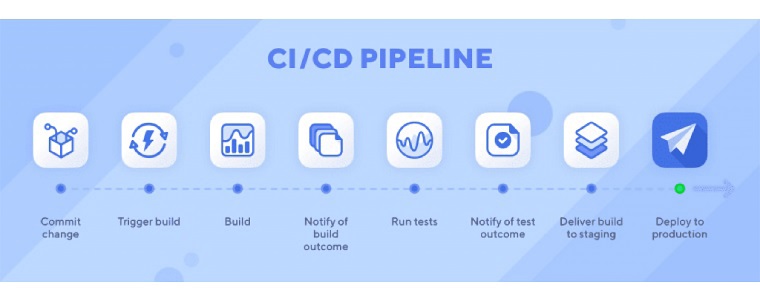The CI/CD pipeline includes continuous integration, delivery, and deployment. DevOps teams use it to generate, test, and release new software automatically. This pipeline benefits from regular software changes and a more collaborative and agile team process. You have probably heard about the benefits of CI/CD tools that provide code more frequently and reliably. Let’s examine what it is and how it benefits software development.
What Does CI/CD Pipeline Stand For?
There are two abbreviations for CI and CD: CI stands for continuous integration and CD for continuous delivery and deployment. Continuous Integration is the software development methodology based on the idea of making incremental code changes frequently and consistently.CI/CD (Continuous Deployment) is also based on this idea. Continuous Integration (CI)-triggered automated build and test stages ensure that code changes submitted into the source are trustworthy.
Integration, testing, delivery, and deployment are some of the processes that make up the CI/CD pipeline for DevOps services. It uses automated testing to identify potential problems earlier and test code changes in various environments. Automated testing covers nearly every aspect of pipeline quality management, including API performance and protection.
Software and app deployments will be more reliable, faster, and of higher quality due to the CI/CD pipeline’s ability to automate multiple stages.
A CI/CD pipeline should be set up before beginning the development process itself, as the parallel operation of CI/CD tools will fundamentally alter your workflow. You must first set up the pipeline phases correctly to make this happen. CI/CD Pipeline phases are now complete.
What’s the Purpose of CI/CD Pipeline?

CI/CD helps companies deliver software on time and budget. It is now possible to bring products to market faster than ever before, ensuring a continuous flow of new features and bug fixes using the most efficient delivery mechanism. CI/CD enables an efficient procedure. Getting back to the point of this article, let’s identify the scenarios in which a CI/CD pipeline is most beneficial.
It Goes Beyond Automated Testing
Quality assurance engineers use automated testing frameworks to write, execute, and automate various types of tests that inform development teams if a software build is successful or not. They create regression tests at the end of each sprint and combine them into a single test for the entire application.
It is important to note that this process does not stop there. Instead, it provides a quick and convenient way to automate processes beyond what was tested above.
Automate Changes To Numerous Environments
It Makes It Easier to Deploy Code Regularly

Businesses that need a dependable way to regularly deliver updates to their apps design CI/CD pipelines. Organising builds, running tests, and automating deployments are all part of the production process for distributing code changes. Once a computing environment has been set up, a team can focus on improving apps rather than on the technical details of transferring them to the environment. As a result, developers may now push updates more frequently because of automation.
Learn More: DevOps Services of Metaorange Digital

